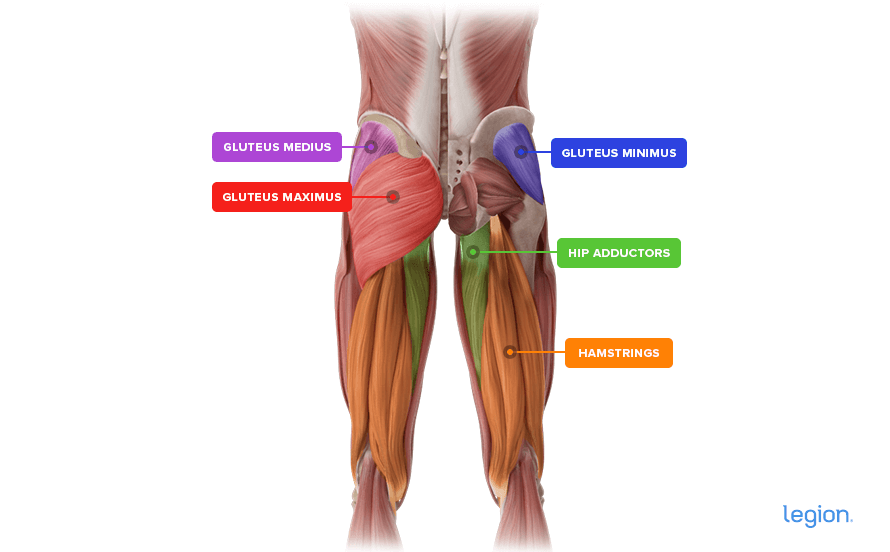[ad_1]
The cable pull-through is a powerful exercise for anyone looking to gain glute and hamstring size and strength.
What makes it so effective is it trains these muscle groups without putting strain on your spine, a benefit not typically seen in other similar exercises. It also helps improve “hip hinge” mechanics, a fundamental movement pattern essential for many athletic movements and daily activities.
In this expert guide, you’ll learn how to do the cable pull-through with proper form, why it’s such a beneficial exercise, the muscles it works, common mistakes people make while performing cable pull-throughs, the best cable pull-through alternatives and variations, and more.
How to Do the Cable Pull-Through
To master cable pull-throughs for glutes and hamstrings size and strength, split the exercise into three parts: set up, hinge, and pull-through.
1. Set up
Adjust the pulley on a cable machine to the lowest setting and attach the rope attachment.
With your back to the pulley, bend down and grab one end of the rope in each hand between your legs. Step forward 2-to-3 steps so the cable is taut, your arms are straight, and your hands are touching the insides of your thighs.
Position your feet slightly wider than shoulder-width apart, stand upright, and flatten your back.
2. Hinge
While maintaining a neutral spine and a slight bend in your knees, hinge at the hips and push your glutes backward, keeping your arms straight as the rope moves between your legs.
Continue pushing your butt back until your upper body is almost parallel to the floor and you feel a stretch in your hamstrings and glutes.
3. Pull through
Reverse the movement by driving your hips forward and squeezing your glutes. This mirrors what you did during the hinge. Here’s how it should look when you put it all together:
The Benefits of Cable Pull-Throughs
1. It allows you to train your glutes and hamstrings when your lower back is tired.
If you only train your glutes and hamstrings with compound exercises like the deadlift and Romanian deadlift, you’ll often have to stop training when your lower back is tired, even though your glutes and hammies could handle more.
The cable pull-through helps in this scenario because it allows you to train your glutes and hamstrings after your back is fried, ensuring they get the stimulus they need to grow.
2. It’s ideal for people with lower back issues.
Unlike most exercises that train the posterior chain (the muscles of the back of your body), the cable pull-through doesn’t load your spine, making it an excellent exercise for those with lower back issues.
3. It allows you to practice the “hip hinge.”
A “hip hinge” is a fundamental movement pattern in which you bend at the hips while keeping your spine neutral. Mastering the hip hinge is crucial for performing various exercises safely and effectively.
Performing cable pull-throughs helps develop this movement pattern, improving your overall exercise technique and reducing the risk of injury.
Muscles Worked By the Cable Pull-Through
The main muscle groups worked by cable pull-throughs are the glutes (gluteus maximus, medius, and minimus), hamstrings, and hip adductors.
Here’s how these muscles look on your body:

Common Cable Pull-Through Mistakes
1. Squatting the weight.
The problem: When performing cable pull-throughs, a common mistake is turning the movement into a squat by bending the knees excessively. This shifts the focus away from the glutes and hamstrings and onto the quads, reducing the effectiveness of the exercise for glute development.
The fix: Focus on hinging at the hips rather than bending the knees. Push your hips back as if you’re trying to close a door behind you with your butt. This will ensure that you’re using your glutes and hamstrings effectively.
2. Standing too close to the machine.
The problem: Standing too close to the machine lets the weight rest on the stack when your muscles are fully stretched, removing the tension at a crucial point and reducing the exercise’s effectiveness.
The fix: Step forward 2-to-3 steps until the weight is off the stack and you feel tension on the cable at the start of the exercise. If you feel the weight rest on the stack at the bottom of your first rep, take another step forward and start your set again.
3. Not using a full range of motion.
The problem: Many people cut the cable pull-through’s range of motion short by not pushing their butt back until they feel a stretch in their glutes and hamstrings and not pushing their hips forward until they fully contract their glutes.
The fix: Ensure you extend your hips fully at the top of each rep and push them back as far as you comfortably can at the bottom.
The Best Cable Pull-Through Alternatives and Variations
1. Barbell Hip Thrust
The barbell hip thrust trains your glutes similarly to the cable pull-through. One notable difference, however, is you can use significantly more weight with the hip thrust, making it superior for gaining glute strength.
2. Romanian Deadlift
The Romanian deadlift (RDL) is an excellent exercise for developing the glutes and hamstrings. It’s also less fatiguing than other deadlift variations, so you can do it more often without wearing yourself to a frazzle.
3. Kettlebell Swing
The kettlebell swing trains all the posterior chain muscles and builds explosive strength that will improve your athletic performance across the board. It also challenges your cardiovascular system, making it one of the few effective ways to combine cardio and strength training in a single exercise.
4. Resistance Band Pull-Through
The resistance band pull-through is a good cable pull-through alternative for those who train at home or while traveling and don’t have access to a cable machine. The only problem is that it places less tension on your glutes and hamstrings when most stretched, reducing overall glute activation and negating some of the muscle-building benefits of the exercise.
5. Kneeling Cable Pull-Through
Some people prefer the kneeling cable pull-through for its increased stability, while others find it awkward. Both effectively train the same muscles, so experiment with each to see which one you like best.
Who Should Do Cable Pull-Throughs?
The cable pull-through is ideal for anyone aiming to build glute and hamstring muscle for several reasons:
- It allows you to isolate your glutes and hamstrings, which means you can train them with the volume they need to grow without other muscle groups becoming the limiting factor.
- It allows you to train these muscles through a different range of motion than other exercises, which likely enhances muscle growth.
- It gives you a break from heavy pulling and squatting, which can help keep training more engaging, fun, and productive.
- It’s easier on the joints than heavy squatting and deadlifting, which may reduce your risk of injury.
Sets and Reps for the Cable Pull-Through
Trying to lift too much weight on the cable pull-through can yank you off balance and make the exercise feel awkward.
As such, it’s typically best to use a higher rep range than you would for other exercises that train similar muscles, like the hip thrust.
Doing 3 sets of 8-to-10 or 10-to-12 reps at the end of a leg or lower-body workout works well for most people.
FAQ #1: Is the cable pull-through worth it?
Yes, the cable pull-through is worth including in your routine, especially if developing your glutes and hamstrings is a priority.
It’s beneficial because it effectively trains your butt and hamstrings even when your lower back is tired.
It also doesn’t stress your spine, making it ideal for people with lower back issues, and it helps you “groove in” the hip hinge movement pattern, which can help improve your technique on other key exercises.
FAQ #2: What is the difference between the cable pull-through and RDL?
The main differences between the cable pull-through and the Romanian deadlift are:
- Equipment used: The cable pull-through uses a cable machine, whereas the Romanian deadlift uses a barbell or dumbbells.
- Direction of resistance: In a cable pull-through, the resistance comes from a cable machine behind you, which trains the glutes and hamstrings with continuous tension. The Romanian deadlift, on the other hand, involves lifting a barbell or dumbbells with the resistance being gravity pulling downwards.
- Weight used: You can lift significantly more weight on the RDL, making it superior for gaining strength.
- Muscles trained: The RDL trains the entire posterior chain, while pull-throughs only train the glutes and hamstrings.
Importantly, neither exercise is better or worse than the other; both have their benefits.
That’s why including both in your routine makes sense, especially if glute growth is a top priority.
Here’s an example lower-body workout including both exercises:
- Back Squat: 3 sets of 6-to-8 reps with 2-to-3 min rest
- Romanian Deadlift: 3 sets of 6-to-8 reps with 2-to-3 min rest
- Leg Press: 3 sets of 8-to-10 reps with 2-to-3 min rest
- Cable Pull-Through: 3 sets of 8-to-10 reps with 2-to-3 min rest
FAQ #3: How can you do a cable pull-through at home?
You can use a resistance band to do a cable pull-through at home without a cable machine.
Secure the band to a low anchor point (a heavy piece of furniture, for example), then face away from the anchor, bend at the hips to grab the band between your legs, and perform the exercise as you would with a cable machine.
Ensure the band provides enough resistance to challenge your muscles but also allows for a full range of motion.
+ Scientific References
- Van Gelder, Leonard H., et al. “EMG Analysis and Sagittal Plane Kinematics of the Two-Handed and Single-Handed Kettlebell Swing: A Descriptive Study.” International Journal of Sports Physical Therapy, vol. 10, no. 6, 1 Nov. 2015, pp. 811–826, pubmed.ncbi.nlm.nih.gov/26618061/.
- Lake, Jason P., and Mike A. Lauder. “Kettlebell Swing Training Improves Maximal and Explosive Strength.” Journal of Strength and Conditioning Research, vol. 26, no. 8, Aug. 2012, pp. 2228–2233, journals.lww.com/nsca-jscr/Pages/articleviewer.aspx?year=2012&issue=08000&article=00028&type=Fulltext, https://doi.org/10.1519/jsc.0b013e31825c2c9b.
- Costa, Bruna Daniella de Vasconcelos, et al. “Does Performing Different Resistance Exercises for the Same Muscle Group Induce Non-Homogeneous Hypertrophy?” International Journal of Sports Medicine, vol. 42, no. 09, 13 Jan. 2021, pp. 803–811, https://doi.org/10.1055/a-1308-3674.
[ad_2]
Source link



